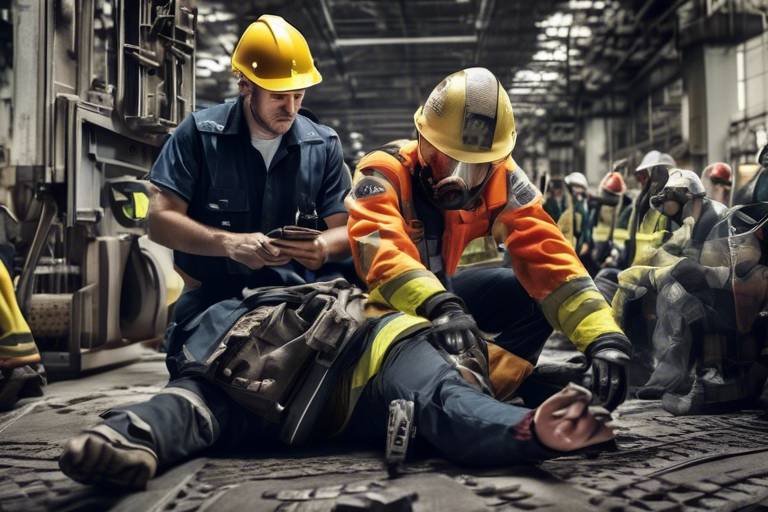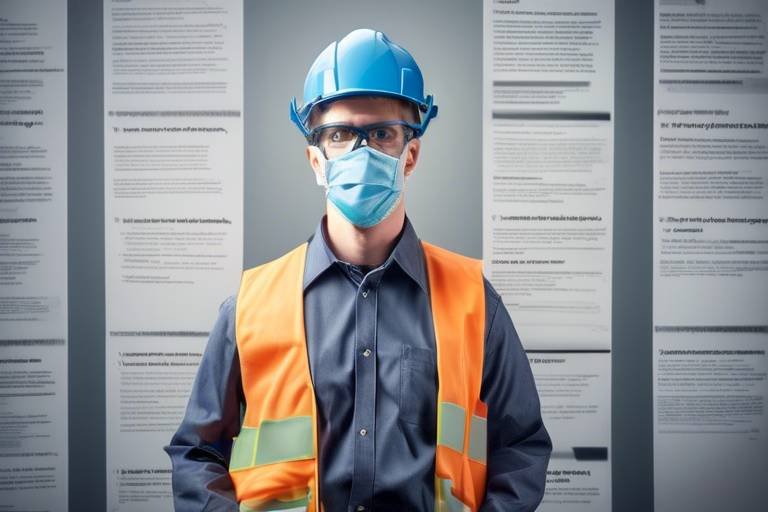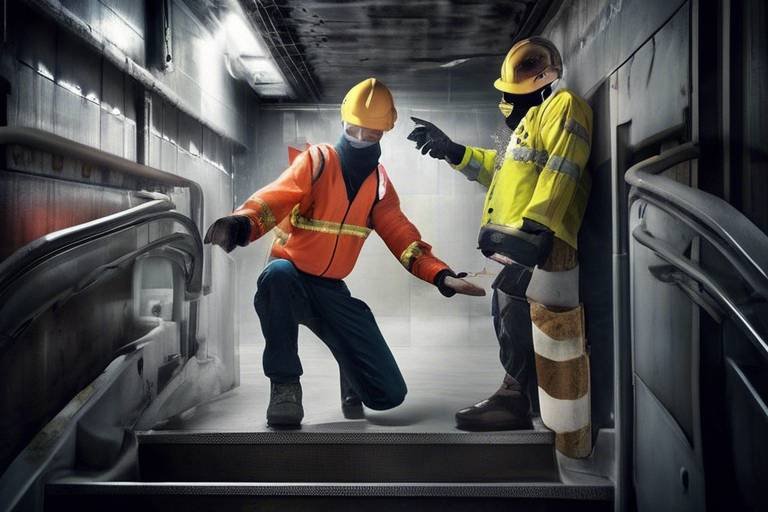Safety Measures: How Human Behavior Shapes Their Efficiency
In today's fast-paced world, safety measures are more critical than ever. But have you ever stopped to wonder how human behavior impacts the effectiveness of these safety protocols? It's fascinating to consider that the way we think, feel, and act can significantly shape our adherence to safety practices. Whether in a workplace, at home, or in public spaces, the relationship between human behavior and safety is intricate and multifaceted. In this article, we will explore how our actions and decisions influence the success of safety measures, making it essential for organizations and individuals alike to understand this dynamic.
Imagine a construction site bustling with activity. Workers are equipped with helmets, harnesses, and other safety gear. Yet, despite these precautions, accidents can still occur. Why? Often, it's because of the choices individuals make in the moment. If a worker feels invincible or believes that "it won't happen to me," they may take unnecessary risks, disregarding safety protocols. This behavior highlights the importance of not only having safety measures in place but also ensuring that they resonate with the people who need to follow them.
Moreover, the effectiveness of safety measures can be enhanced through a deeper understanding of psychology. When individuals comprehend the reasons behind safety protocols, they are more likely to comply. For instance, if employees are educated about the consequences of neglecting safety measures—such as injury or even loss of life—they may be more inclined to prioritize safety in their daily routines. This connection between knowledge and behavior is crucial in fostering a culture of safety.
Additionally, the role of social influence cannot be overstated. People are inherently social beings; we observe and mimic the behaviors of those around us. If a workplace promotes a strong safety culture, where everyone adheres to protocols and looks out for one another, it creates an environment where safety becomes a shared responsibility. Conversely, if employees witness their peers cutting corners or ignoring safety measures, they may feel compelled to do the same. This highlights the need for organizations to cultivate a supportive atmosphere that encourages safe practices.
In conclusion, the interplay between human behavior and safety measures is a vital consideration for enhancing safety in any environment. By understanding the psychological factors that drive compliance, leveraging social influences, and fostering a culture of safety, we can significantly improve adherence to safety protocols. As we delve deeper into this topic, we'll explore behavioral economics, technology's role, and cultural factors that further shape our safety behaviors.
- What are the key factors that influence safety behavior?
Key factors include psychological motivators, social influences, and organizational culture, all of which play a significant role in shaping how individuals approach safety measures. - How can organizations improve compliance with safety protocols?
Organizations can enhance compliance by providing effective training, fostering a culture of safety, and utilizing technology to monitor and promote safe behaviors. - What role does technology play in enhancing safety measures?
Technology, such as wearable devices and data analytics, can provide real-time feedback on behaviors, helping individuals recognize potential risks and adhere to safety protocols more effectively. - Why is understanding risk perception important for safety?
Understanding how individuals perceive risk helps organizations tailor their safety measures and communication strategies, ensuring that people recognize the importance of compliance.

The Psychology of Safety Compliance
Understanding the psychology behind safety compliance is like peeling back the layers of an onion—each layer reveals more about why people behave the way they do when it comes to safety measures. At the core, human behavior is influenced by a myriad of factors, including emotions, social interactions, and cognitive biases. These psychological elements play a crucial role in determining whether individuals adhere to safety protocols or choose to ignore them, often with serious consequences.
One major psychological factor influencing safety compliance is the concept of motivation. Employees are more likely to follow safety measures if they feel a personal stake in the outcome. This can be driven by a variety of motivators, such as fear of injury, desire for job security, or even the need for social approval. Think about it: when you know that your actions can directly impact your well-being or that of your colleagues, you’re likely to be more vigilant. Conversely, if individuals perceive safety measures as mere bureaucratic hurdles, their compliance may wane.
Another layer to this psychological puzzle is the perception of risk. People often have different thresholds for what they consider risky behavior. This is where cognitive biases, such as optimism bias, come into play. Many individuals believe that accidents happen to others, not to them. As a result, they may underestimate the importance of safety measures, thinking, “I’m careful enough; nothing will happen to me.” This overconfidence can lead to dangerous shortcuts and complacency regarding established safety protocols.
Social dynamics also significantly impact safety compliance. The influence of peers cannot be overstated; people often look to their coworkers for cues on how to behave. If the prevailing culture in a workplace downplays safety, individuals may feel pressure to conform, even if they personally value safety. This phenomenon is known as social proof, where individuals mimic the behaviors of those around them. Therefore, fostering a culture that prioritizes safety is not just beneficial; it’s essential. When employees see their peers actively engaging in safe practices, they are more likely to follow suit.
Moreover, effective training and education can significantly alter perceptions and behaviors regarding safety. When employees are educated about the risks associated with their jobs and the importance of safety protocols, they are more likely to internalize these lessons. This isn't just about ticking boxes; it's about creating an environment where safety becomes second nature. For instance, regular safety drills and workshops can reinforce the importance of compliance, making it a core aspect of the workplace culture.
To summarize, the psychology of safety compliance is a complex interplay of motivation, risk perception, social influences, and education. Recognizing these factors can help organizations develop more effective safety programs that resonate with employees on a personal level, ultimately leading to a safer workplace for everyone.
- What are the main psychological factors affecting safety compliance?
These include motivation, risk perception, and social influences. - How does training impact safety behavior?
Effective training enhances understanding and encourages adherence to safety protocols. - What role does organizational culture play in safety compliance?
A strong safety-oriented culture fosters better compliance among employees.

Behavioral Economics in Safety Protocols
Behavioral economics delves into the psychological factors that influence our decision-making processes, particularly when it comes to adhering to safety protocols. It’s fascinating how our choices are often swayed by incentives and disincentives, rather than pure logic. Imagine standing at a crossroads: one path is a well-marked road of safety, while the other is a winding trail of risks. What makes you choose one over the other? Behavioral economics seeks to answer that question by examining how various factors can nudge us towards safer choices.
One of the key principles of behavioral economics is the concept of loss aversion. This principle suggests that the fear of losing something is a more potent motivator than the prospect of gaining something of equal value. In the context of safety protocols, this means that if individuals perceive a significant risk of loss—be it their health, job security, or even financial stability—they are more likely to comply with safety measures. For instance, a construction worker might be more inclined to wear a hard hat if they understand that failing to do so could result in severe injury or loss of income.
Moreover, the implementation of incentives can significantly impact safety behavior. Organizations often employ various strategies to encourage compliance with safety protocols, such as:
- Monetary rewards for teams that maintain zero accidents over a specific period.
- Recognition programs that highlight individuals who consistently follow safety guidelines.
- Providing additional training or resources as a reward for adherence to safety measures.
These incentives serve as powerful motivators that can lead to a culture of safety within organizations. However, it’s essential to balance these incentives with appropriate disincentives. For example, organizations might impose penalties for repeated non-compliance with safety protocols. This dual approach can effectively reinforce safe behaviors while discouraging risky practices.
Another interesting aspect is the role of default options in shaping safety behavior. People tend to stick with the default choice, whether it's enrolling in a safety program or using protective equipment. By setting safety measures as the default option—such as requiring safety gear to be worn at all times—organizations can significantly enhance compliance. This strategy takes advantage of our inherent tendency to go with the flow, reducing the cognitive load associated with decision-making.
Lastly, the environment in which safety protocols are implemented plays a crucial role. A well-designed workspace that emphasizes safety can lead to better compliance. For instance, clear signage, easy access to safety equipment, and regular reminders can make a significant difference. Behavioral economics suggests that by modifying the environment, we can effectively influence behavior without needing to rely solely on willpower or motivation.
In conclusion, understanding the principles of behavioral economics provides valuable insights into how to enhance safety protocols. By recognizing the psychological factors that drive behavior, organizations can create more effective strategies that encourage compliance, ultimately leading to safer workplaces. It’s about creating an environment where safety is not just a rule, but a way of life.

Risk Perception and Decision Making
When it comes to safety measures, the way individuals perceive risk plays a crucial role in their decision-making processes. Imagine standing at the edge of a cliff; the way you assess the danger of falling can dictate whether you take a step back or leap forward. Similarly, in everyday situations, how we interpret risks can heavily influence our choices regarding safety protocols. For instance, if an employee believes that a task is low-risk, they might bypass essential safety measures, thinking, “It won’t happen to me.” This overconfidence can lead to a dangerous mindset where safety protocols are viewed as unnecessary inconveniences rather than vital precautions.
Moreover, risk perception isn’t just a personal affair; it’s often shaped by external factors such as social influences, previous experiences, and cultural contexts. For example, if a workplace has a history of accidents, employees may heighten their perception of risk, leading to more cautious behavior. On the flip side, if colleagues frequently disregard safety measures without any apparent consequences, new employees might adopt the same lax attitude, believing that the risk is minimal. This phenomenon highlights the importance of fostering a culture where safety is prioritized and openly discussed.
To further understand this relationship between risk perception and decision-making, we can explore how different factors come into play:
- Personal Experience: Individuals who have faced accidents or near-misses are more likely to perceive risks accurately and adhere to safety measures.
- Social Norms: If safety compliance is the norm in a workplace, individuals are more likely to follow suit, reinforcing a culture of safety.
- Information Availability: Access to information about potential risks can enhance awareness and lead to better decision-making regarding safety protocols.
Ultimately, understanding risk perception can empower organizations to tailor their safety training and communication strategies. By addressing the psychological aspects of risk, companies can create an environment where safety is not just a checklist but a core value ingrained in the workplace culture. This proactive approach can significantly reduce accidents and enhance overall safety compliance.
- What is risk perception? Risk perception refers to an individual's assessment of the potential hazards associated with a particular situation or behavior.
- How does risk perception influence safety behavior? Individuals with heightened risk perception are more likely to adhere to safety measures, while those with low risk perception may disregard them.
- Can training improve risk perception? Yes, effective training programs can enhance individuals' understanding of risks, leading to better compliance with safety protocols.
- What role does organizational culture play in risk perception? A strong safety-oriented culture can positively influence employees' risk perceptions, encouraging them to prioritize safety in their decision-making processes.

Overconfidence Bias
Overconfidence bias is a fascinating psychological phenomenon that can have serious implications for safety compliance. It’s that feeling we all get when we think we’re invincible, like when you confidently juggle chainsaws at a circus, believing nothing can go wrong. This bias leads individuals to underestimate risks and overestimate their abilities, creating a dangerous cocktail of overconfidence and negligence. In the context of workplace safety, this can result in individuals ignoring established protocols, believing they are somehow exempt from accidents or injuries.
Imagine a construction worker who feels experienced enough to skip wearing a hard hat because “nothing’s ever happened to me before.” This overconfidence can lead to catastrophic outcomes. Studies have shown that people who exhibit overconfidence are less likely to adhere to safety measures, as they believe they can handle any situation without protection. This mindset not only puts the individual at risk but can also endanger their coworkers, creating a ripple effect of unsafe behavior.
To combat overconfidence bias, organizations can implement several strategies. Here are a few effective approaches:
- Regular Training: Continuous education on safety protocols can remind employees of the inherent risks associated with their tasks.
- Real-Life Scenarios: Sharing stories and case studies about accidents caused by overconfidence can help ground employees in reality, emphasizing that safety is a shared responsibility.
- Encouraging a Safety Culture: Fostering an environment where safety is prioritized and openly discussed can help mitigate the effects of overconfidence.
Additionally, it’s crucial to incorporate feedback mechanisms where employees can report unsafe behaviors without fear of repercussions. When individuals recognize that their actions impact not just themselves but the entire team, they are more likely to adjust their behaviors. Overconfidence can be a silent killer in the workplace, but with the right strategies and a culture of safety, organizations can turn the tide and promote a safer working environment for everyone.
Q1: What is overconfidence bias?
A1: Overconfidence bias is a cognitive bias where individuals overestimate their own abilities or knowledge, leading them to underestimate risks associated with certain actions, especially in safety contexts.
Q2: How does overconfidence bias affect workplace safety?
A2: It can lead employees to ignore safety protocols, thinking they can handle situations without protective measures, which increases the likelihood of accidents and injuries.
Q3: What can organizations do to reduce overconfidence bias?
A3: Organizations can provide regular safety training, share real-life accident stories, and encourage a culture of safety where employees feel responsible for their own and others' safety.

Social Influence on Safety Behavior
When it comes to safety behavior, it’s often said that no person is an island. This phrase rings particularly true in the context of workplace safety and compliance with safety protocols. Our behaviors are heavily influenced by the people around us—whether they are colleagues, friends, or family. This social influence can either bolster our commitment to safety measures or, conversely, lead us to disregard them entirely. Have you ever noticed how the actions of your peers can sway your own decisions? That's the power of social dynamics at play!
Social norms dictate what is considered acceptable behavior within a group. For example, if safety gear is consistently worn by most employees in a workplace, new hires are likely to adopt the same practice. This creates a culture of safety, where adherence to safety protocols becomes the norm rather than the exception. Conversely, if safety measures are ignored by peers, individuals may feel less inclined to comply, thinking, “If they don’t care, why should I?” This peer pressure can have profound effects on safety behavior.
To illustrate this point, let’s consider a scenario in a construction site. If the majority of workers wear helmets and safety vests, newcomers are more likely to follow suit. However, if they see a few seasoned workers disregarding these measures, they might feel emboldened to do the same, believing that they can “get away with it.” This underscores the importance of fostering a strong safety culture where everyone feels responsible for each other’s safety.
Moreover, leadership plays a crucial role in shaping these social influences. When leaders prioritize safety and model safe behaviors, it sends a clear message to employees about the importance of compliance. A leader who insists on wearing protective gear and encourages others to do the same creates an environment where safety is valued. This can be further enhanced through regular safety meetings, workshops, and open discussions about safety practices, which can help reinforce positive behaviors across the board.
Interestingly, social influence can also be harnessed through incentive programs. For instance, organizations can implement reward systems that recognize teams or individuals who consistently adhere to safety protocols. This not only motivates compliance but also creates a sense of camaraderie among employees. When people see their peers being rewarded for safe practices, it fosters a collective responsibility towards safety.
In conclusion, the impact of social influence on safety behavior is undeniable. By understanding and leveraging these social dynamics, organizations can enhance their safety measures and create a culture that values compliance. After all, safety is not just an individual responsibility; it's a collective effort that thrives in an environment of mutual support and accountability.
- How does social influence affect safety compliance?
Social influence affects safety compliance by shaping individuals' perceptions of acceptable behavior within their peer groups. When safety measures are adhered to by colleagues, new employees are more likely to follow suit. - What role do leaders play in promoting safety?
Leaders set the tone for safety culture. By modeling safe behaviors and prioritizing safety in their communications, they can significantly influence their team's adherence to safety protocols. - Can incentive programs improve safety behavior?
Yes! Incentive programs that reward safe practices can motivate individuals to comply with safety measures and foster a culture of accountability.

Training and Education Effects
When it comes to safety measures, the importance of training and education cannot be overstated. Imagine stepping into a workplace where employees are not only aware of the safety protocols but are also actively engaged in following them. This scenario is not just a dream; it can be a reality through effective training programs. These programs serve as the backbone of safety compliance, transforming passive knowledge into active behavior. By equipping individuals with the necessary skills and understanding, organizations can significantly reduce the likelihood of accidents and enhance overall safety.
One of the key aspects of successful training is its ability to change attitudes towards safety. When individuals recognize the value of safety measures, they are more likely to adopt them as part of their daily routines. For instance, consider a scenario where employees are educated about the potential consequences of ignoring safety protocols. This knowledge can create a sense of urgency and responsibility, motivating them to prioritize safety in their work environment. Furthermore, training should not be a one-time event; it needs to be ongoing. Regular refresher courses can help reinforce the importance of safety measures and keep them top of mind.
Moreover, the effectiveness of training can be enhanced by incorporating interactive elements. Engaging employees through hands-on activities, simulations, and real-life scenarios can make learning more impactful. For example, rather than simply lecturing about the importance of wearing personal protective equipment (PPE), organizations can conduct practical workshops where employees practice putting on and using the gear in various situations. This experiential learning approach not only boosts confidence but also solidifies the knowledge gained.
Another significant factor in the success of training programs is the involvement of leadership. When leaders actively participate in safety training, it sends a powerful message that safety is a priority. Employees are likely to mirror the behaviors of their leaders, creating a culture of safety that permeates the organization. In fact, a study revealed that organizations with strong leadership commitment to safety experience lower accident rates compared to those without such commitment. This highlights the pivotal role that organizational culture plays in shaping safety behaviors.
In addition to traditional training methods, leveraging technology can amplify the effects of education on safety compliance. Online training modules, virtual reality simulations, and mobile applications can provide employees with flexible learning opportunities that fit their schedules. These tools can also facilitate real-time feedback, allowing individuals to assess their understanding and application of safety measures. As technology continues to evolve, integrating it into training programs can lead to more effective and engaging learning experiences.
In conclusion, the effects of training and education on safety compliance are profound. By investing in comprehensive training programs, organizations not only enhance the knowledge and skills of their employees but also foster a culture that prioritizes safety. The combination of ongoing education, interactive learning, leadership involvement, and technological integration creates a robust framework for promoting safe practices. Ultimately, when individuals feel empowered and informed, they are more likely to adhere to safety measures, resulting in a safer workplace for everyone.
- Why is training important for safety compliance?
Training equips employees with the knowledge and skills necessary to understand and follow safety protocols, significantly reducing the risk of accidents. - How often should safety training be conducted?
Safety training should be ongoing, with regular refresher courses to reinforce knowledge and keep safety top of mind. - What role does leadership play in safety training?
Active participation from leadership demonstrates a commitment to safety, encouraging employees to prioritize safe practices. - Can technology enhance safety training?
Yes, technology can provide flexible learning opportunities, real-time feedback, and engaging content that improves the effectiveness of training programs.

Technology’s Role in Enhancing Safety
In today's fast-paced world, technology plays a pivotal role in enhancing safety across various domains. From workplaces to public spaces, the integration of advanced technologies has revolutionized how we approach safety measures. Imagine a workplace where potential hazards are detected before they can cause harm; that’s the power of modern technology! By leveraging innovative solutions, organizations can not only comply with safety regulations but also foster a culture of proactive risk management.
One of the most exciting advancements in safety technology is the rise of wearable safety devices. These gadgets, often equipped with sensors and alert systems, monitor individuals' behaviors in real time. For instance, construction workers can wear helmets that detect falls or fatigue, sending alerts to supervisors if a worker is at risk. This immediate feedback loop not only enhances individual safety but also promotes a collective responsibility for safety within teams. The integration of such devices can lead to a significant decrease in workplace accidents.
Moreover, data analytics has emerged as a game-changer in understanding behavioral patterns related to safety. By collecting and analyzing data from various sources—such as incident reports, employee feedback, and wearable device metrics—organizations can gain valuable insights into safety trends. This data-driven approach allows them to identify areas of concern and refine their safety measures accordingly. For example, if data reveals that most accidents occur during specific shifts or under certain conditions, management can implement targeted training and resources to mitigate those risks.
Another technological advancement that enhances safety is the use of communication tools designed specifically for emergency situations. These tools enable quick and effective communication among team members, ensuring that everyone is aware of potential hazards and necessary precautions. For instance, mobile apps can send instant alerts to workers about changing conditions, such as severe weather or equipment malfunctions. This real-time communication can be the difference between a safe work environment and a potentially dangerous situation.
As we continue to embrace technology, it's crucial to recognize that it should complement human behavior rather than replace it. While tech solutions provide invaluable support, the effectiveness of safety measures ultimately depends on individuals' willingness to engage with these technologies. Therefore, organizations must invest not only in the latest gadgets but also in training employees to use them effectively. A well-informed workforce that understands the importance of these technologies can significantly enhance overall safety compliance.
In conclusion, technology is reshaping the landscape of safety measures, making them more effective and efficient. By integrating wearable devices, utilizing data analytics, and enhancing communication, organizations can create safer environments for their employees and stakeholders. As we look to the future, it’s essential to keep pushing the boundaries of what technology can do to protect lives, ensuring that safety is always at the forefront of our efforts.
- What are wearable safety devices? Wearable safety devices are gadgets equipped with sensors that monitor individual behavior and alert users to potential safety risks.
- How does data analytics improve safety? Data analytics helps organizations identify safety trends and areas of concern by analyzing data from incidents and employee feedback.
- Why is communication important in safety? Effective communication ensures that all team members are aware of potential hazards and can respond quickly during emergencies.
- How can organizations encourage the use of safety technology? Organizations can encourage the use of safety technology by providing training and emphasizing its importance in maintaining a safe work environment.

Wearable Safety Devices
In today's fast-paced world, are revolutionizing the way we approach personal safety across various environments. These innovative gadgets, ranging from smart helmets to health-monitoring wristbands, are designed not just for convenience but to actively enhance our safety protocols. Imagine a scenario where a construction worker is alerted in real-time about potential hazards or a factory employee receives immediate notifications about unsafe conditions. This is the power of wearable technology!
Wearable safety devices operate on the principle of proactive monitoring. They collect data about the user’s environment and physiological state, using sensors to track everything from heart rate and body temperature to exposure to harmful chemicals. For instance, a smart helmet equipped with sensors can detect changes in atmospheric conditions, alerting the wearer to potential dangers such as gas leaks or extreme temperatures. This real-time feedback loop not only helps individuals stay safe but also fosters a culture of safety within organizations.
One of the most compelling features of these devices is their ability to promote accountability. When workers know they are being monitored, they are more likely to adhere to safety protocols. For example, a construction site that employs wearable safety devices can significantly reduce accidents by ensuring that all personnel are following safety guidelines. This can be further enhanced by integrating these devices with organizational safety systems, allowing for immediate reporting and response to incidents.
Moreover, the data collected from wearable devices can be analyzed to identify trends and areas for improvement. Organizations can use this information to refine their safety protocols, ensuring they are not only compliant with regulations but also tailored to the specific needs of their workforce. By understanding how employees interact with their environments, companies can implement targeted training programs that address identified gaps in safety practices.
However, it’s essential to recognize that the effectiveness of wearable safety devices is contingent upon user acceptance and proper training. Employees must understand how to use these devices effectively and appreciate their value in enhancing personal safety. Therefore, organizations should invest in comprehensive training programs that not only teach employees how to use these devices but also emphasize the importance of safety in the workplace.
In conclusion, wearable safety devices represent a significant leap forward in the quest for improved safety measures. By leveraging technology to monitor and promote safe behaviors, we can create environments where individuals feel empowered to prioritize their safety and the safety of those around them. As we continue to innovate and integrate these technologies into our daily lives, the potential for reducing accidents and enhancing safety protocols is limitless.
- What are wearable safety devices? Wearable safety devices are gadgets designed to monitor and enhance personal safety through real-time data collection and alerts.
- How do they work? These devices use sensors to track environmental conditions and physiological data, providing users with immediate feedback on potential hazards.
- Can wearable safety devices improve compliance with safety protocols? Yes, they promote accountability and encourage adherence to safety measures by keeping users informed about their surroundings.
- What types of industries benefit from wearable safety devices? Industries such as construction, manufacturing, and healthcare can significantly benefit from integrating these devices into their safety protocols.

Data Analytics for Behavioral Insights
In today's fast-paced world, data analytics has emerged as a game changer in understanding human behavior, particularly when it comes to safety protocols. Organizations are increasingly relying on data to uncover behavioral patterns that can inform and enhance their safety measures. By analyzing data collected from various sources—such as incident reports, employee feedback, and even wearable safety devices—companies can gain valuable insights into how employees interact with safety protocols.
Imagine walking into a workplace where every employee is aware of the potential hazards, not just because they were told to be cautious, but because the data supports it. This is the power of data analytics! It allows organizations to identify trends, such as common safety violations or areas where employees feel less safe. For instance, if data shows that a particular department has a higher rate of accidents, management can investigate further to understand the underlying causes, whether it's a lack of training, unclear protocols, or even environmental factors.
Additionally, data analytics can help in predicting future behaviors. By utilizing predictive analytics, organizations can forecast potential risks and implement preventive measures before accidents occur. This proactive approach not only enhances safety but also fosters a culture of responsibility among employees. They start to see that their actions are being monitored and analyzed, which can lead to a greater sense of accountability.
Moreover, the integration of real-time data monitoring can significantly improve compliance rates. For example, organizations can use dashboards that display safety compliance metrics, allowing employees to see how they measure up against safety standards. This transparency encourages individuals to adhere more closely to safety protocols, as they are constantly reminded of their performance and its impact on the overall safety of the workplace.
To illustrate the effectiveness of data analytics in shaping safety behavior, consider the following table that outlines how various data sources can be utilized to enhance safety measures:
| Data Source | Insight Gained | Actionable Outcome |
|---|---|---|
| Incident Reports | Identifying frequent safety violations | Targeted training sessions |
| Employee Surveys | Understanding employee perceptions of safety | Improving communication and protocols |
| Wearable Devices | Monitoring real-time safety compliance | Immediate alerts for unsafe behaviors |
Ultimately, leveraging data analytics for behavioral insights not only enhances the effectiveness of safety measures but also empowers employees to take ownership of their safety practices. It transforms the concept of safety from a mere compliance obligation into a shared responsibility that everyone actively participates in. As organizations continue to embrace this data-driven approach, we can expect to see significant improvements in workplace safety and a reduction in accidents.
- What is the role of data analytics in workplace safety? Data analytics helps organizations understand employee behavior, identify trends, and predict potential risks, leading to improved safety measures.
- How can real-time data monitoring improve safety compliance? Real-time monitoring provides immediate feedback to employees about their safety practices, encouraging them to adhere to protocols.
- What types of data sources are most effective for analyzing safety behavior? Incident reports, employee surveys, and wearable devices are among the most effective data sources for gaining insights into safety behavior.

Cultural Factors Influencing Safety Behavior
Cultural attitudes towards safety can significantly influence individuals’ behaviors, impacting the overall effectiveness of safety measures in diverse environments. In many cases, safety practices are not merely rules to follow but are deeply ingrained in the cultural fabric of a society. For instance, in cultures where risk-taking is celebrated, individuals may be less inclined to adhere strictly to safety protocols. Conversely, in cultures that prioritize caution and risk aversion, compliance with safety measures can be notably higher. This cultural dichotomy is essential to understand when developing effective safety strategies.
Moreover, the concept of collectivism versus individualism plays a crucial role in shaping safety behaviors. In collectivist cultures, where group harmony and community well-being are emphasized, individuals may feel a greater responsibility to follow safety measures, not just for their own sake but for the sake of their peers. On the other hand, in individualistic cultures, personal freedom and self-reliance may lead to a more relaxed attitude towards safety protocols. This difference can create challenges in multinational organizations where diverse cultural attitudes coexist.
Furthermore, the communication style prevalent in a culture can affect how safety messages are received. For example, cultures that value direct communication may respond better to clear, explicit safety instructions, while those that favor indirect communication may require a more nuanced approach. Understanding these cultural nuances can be the key to crafting effective safety campaigns that resonate with the intended audience.
To illustrate this further, let’s take a look at a
| Cultural Dimension | Collectivist Cultures | Individualistic Cultures |
|---|---|---|
| Risk Attitude | Risk-averse, prioritize group safety | Risk-tolerant, prioritize personal freedom |
| Communication Style | Indirect, context-driven | Direct, explicit |
| Compliance Motivation | Group accountability, social pressure | Personal responsibility, self-interest |
Additionally, it’s important to recognize that cultural factors extend beyond just national boundaries. Within a single country, different regions may exhibit varying safety behaviors based on local customs and traditions. For example, in a country with a diverse population, urban areas may have different safety practices compared to rural areas, influenced by local norms and economic conditions. This regional variation necessitates a tailored approach to safety that considers local cultural dynamics.
In conclusion, cultural factors are a significant determinant of safety behavior. By understanding and respecting these cultural influences, organizations can develop more effective safety protocols that resonate with their workforce, ultimately leading to a safer environment for everyone. It is not just about enforcing rules; it is about fostering a culture of safety that aligns with the values and behaviors of the people involved.
- How do cultural attitudes towards safety vary across countries? Cultural attitudes can vary widely, with some cultures emphasizing risk aversion and others promoting a more relaxed attitude towards safety protocols.
- What role does communication play in safety compliance? The communication style of a culture can significantly affect how safety messages are received and adhered to, with direct communication often being more effective in individualistic cultures.
- Can regional differences impact safety behaviors? Yes, even within a single country, regional customs and economic conditions can lead to variations in safety practices.

Cross-Cultural Comparisons
When we talk about safety behaviors, we can't ignore the profound impact of cultural differences. Each culture has its unique set of beliefs, values, and social norms that shape how individuals perceive and respond to safety measures. For instance, in some cultures, there is a strong emphasis on communal responsibility, where safety is seen as a collective duty. In contrast, others may prioritize individual freedom, leading to a more relaxed approach towards compliance with safety protocols.
Consider the example of workplace safety in countries like Japan and the United States. In Japan, the concept of “kaizen”, or continuous improvement, deeply influences safety practices. Employees are encouraged to actively participate in safety discussions and are often involved in the development of safety protocols. This cultural approach fosters a sense of ownership and responsibility, resulting in higher compliance rates. On the other hand, in the United States, while regulations are strict, the emphasis on individualism may lead to a perception that safety compliance is a personal choice rather than a collective responsibility.
To illustrate these differences, let’s take a look at the following table that summarizes key cultural attitudes towards safety:
| Country | Cultural Attitude | Impact on Safety Compliance |
|---|---|---|
| Japan | Collectivism, Continuous Improvement | High compliance due to shared responsibility |
| United States | Individualism, Personal Freedom | Variable compliance, often based on personal choice |
| Germany | Precision, Planning | High compliance due to structured regulations |
| Brazil | Flexibility, Adaptability | Moderate compliance, influenced by situational factors |
These cross-cultural comparisons reveal that understanding the local context is crucial for developing effective safety measures. Organizations looking to implement safety protocols in diverse environments must consider these cultural nuances. For instance, in cultures where collective responsibility is valued, promoting teamwork in safety training could enhance compliance. Conversely, in more individualistic cultures, framing safety measures as personal benefits might resonate better with employees.
Ultimately, fostering a safety-oriented culture requires more than just implementing rules; it involves engaging with employees at a cultural level. By recognizing and respecting the cultural backgrounds of the workforce, organizations can tailor their safety strategies to align with these values, leading to improved adherence to safety protocols and a safer working environment for everyone.
- What are cross-cultural comparisons in safety behavior? Cross-cultural comparisons examine how different cultural attitudes and beliefs influence individuals' compliance with safety measures.
- Why is cultural understanding important for safety protocols? Cultural understanding helps organizations tailor safety measures to align with local values, enhancing compliance and effectiveness.
- How can organizations improve safety compliance across cultures? Organizations can improve compliance by engaging employees in safety discussions and adapting safety training to reflect cultural norms.

Organizational Culture's Impact
When we talk about safety in the workplace, we often think about the rules and regulations that are put in place to protect employees. However, the organizational culture plays a pivotal role in determining how effective these safety measures actually are. Imagine a workplace where safety is not just a checkbox on a compliance form but a core value embraced by every employee. This kind of culture can significantly enhance adherence to safety protocols and ultimately reduce workplace accidents.
In organizations where safety is prioritized, you’ll find that employees are more likely to engage with safety training, report unsafe conditions, and take personal responsibility for their own safety as well as that of their colleagues. This is not merely about following rules; it’s about fostering a sense of community and shared responsibility. When employees feel that their well-being is genuinely valued, they are more inclined to adopt safe practices and encourage others to do the same.
Moreover, leadership plays a crucial role in shaping this culture. Leaders who actively demonstrate a commitment to safety—by participating in training sessions, addressing safety concerns promptly, and recognizing safe behaviors—set a powerful example for their teams. This can create a ripple effect, where employees feel empowered to speak up about safety issues, knowing that their voices will be heard and respected. To illustrate this point, consider the following table that highlights key aspects of how organizational culture influences safety behavior:
| Aspect | Positive Impact on Safety | Negative Impact on Safety |
|---|---|---|
| Leadership Commitment | Encourages employee participation | Creates a culture of negligence |
| Employee Engagement | Increases reporting of hazards | Reduces accountability |
| Communication | Fosters open dialogue about safety | Leads to misunderstandings and risks |
| Recognition Programs | Motivates safe behavior | Discourages compliance |
It's also essential to understand that organizational culture is not static; it evolves over time. Regular assessments and feedback loops can help organizations identify areas for improvement. For instance, conducting anonymous surveys can provide insights into employee perceptions about safety and the effectiveness of existing protocols. By acting on this feedback, organizations can continuously refine their safety culture, making it more robust and resilient.
In conclusion, the impact of organizational culture on safety measures cannot be overstated. A strong safety culture not only enhances compliance but also fosters a proactive approach to identifying and mitigating risks. As employees become more engaged and feel a sense of ownership over their safety and that of their peers, the workplace transforms into a safer environment for everyone. After all, safety is not just a set of rules—it's a way of life that begins with a culture that values it above all else.
- What is organizational culture? Organizational culture refers to the shared values, beliefs, and practices that shape how members of an organization interact and work together.
- How does culture affect safety in the workplace? A strong safety culture promotes adherence to safety protocols, encourages reporting of unsafe conditions, and fosters a sense of responsibility among employees.
- What role do leaders play in shaping safety culture? Leaders set the tone for safety culture by demonstrating commitment, engaging with employees, and recognizing safe practices.
- Can organizational culture change over time? Yes, organizational culture is dynamic and can be improved through regular assessments, feedback, and active engagement from all levels of the organization.
Frequently Asked Questions
- What are the key psychological factors that influence safety compliance?
Understanding psychological factors like motivation, risk perception, and social influence is crucial. Individuals often comply with safety measures when they feel a personal responsibility and see the value in adhering to protocols. Additionally, social norms can heavily influence behavior, making it important to foster a culture of safety.
- How does behavioral economics relate to safety protocols?
Behavioral economics examines how incentives and disincentives affect individuals' adherence to safety measures. By understanding what motivates people, organizations can design better safety protocols that encourage compliance, such as rewards for safe behavior or penalties for non-compliance.
- What role does overconfidence bias play in safety behavior?
Overconfidence bias can lead individuals to underestimate risks and ignore safety measures. When people feel overly confident in their abilities or judgment, they may take unnecessary risks, which can significantly increase the likelihood of accidents.
- How can training and education improve safety behaviors?
Effective training programs are essential for changing attitudes towards safety. By providing individuals with the knowledge and skills they need, organizations can foster an environment where adherence to safety protocols becomes second nature.
- What technological advancements are enhancing safety measures?
Advancements like wearable safety devices and data analytics are revolutionizing safety protocols. Wearables can monitor behavior and alert users to potential risks, while data analytics helps organizations identify trends and improve compliance rates.
- How do cultural factors influence safety behavior?
Cultural attitudes towards safety can vary significantly across different regions and organizations. Understanding these cultural differences is vital for implementing effective safety measures that resonate with diverse populations.
- What is the impact of organizational culture on safety compliance?
A strong organizational culture that prioritizes safety can lead to better compliance among employees. When safety is embedded in the company’s values, employees are more likely to take safety protocols seriously and engage in safe practices.



















